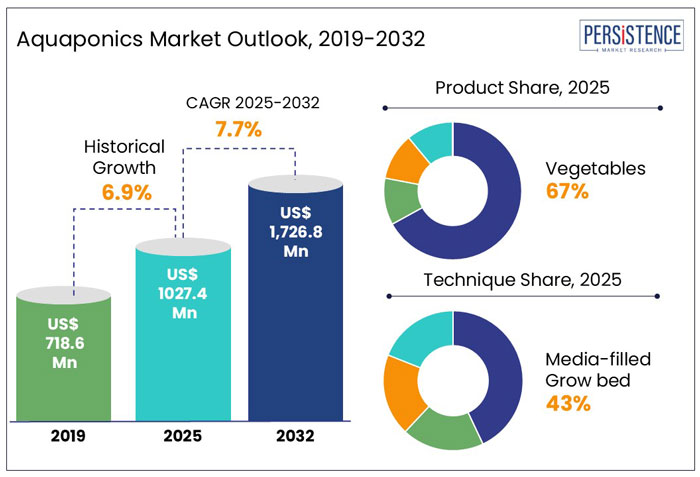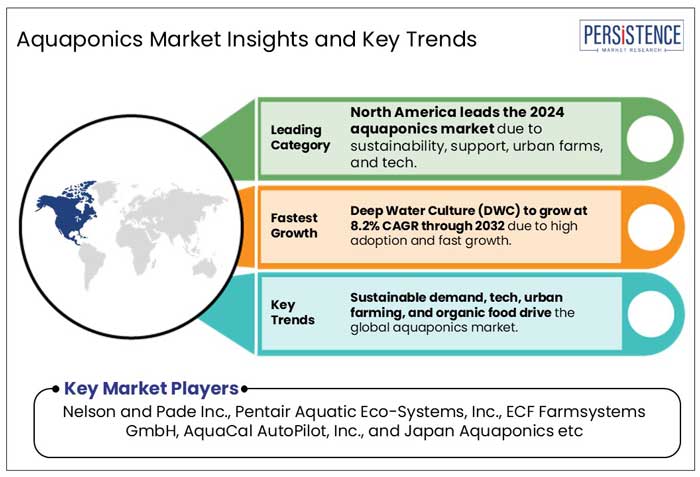Industry: Food and Beverages
Published Date: February-2025
Format: PPT*, PDF, EXCEL
Delivery Timelines: Contact Sales
Number of Pages: 193
Report ID: PMRREP27652
According to Persistence Market Research, the global aquaponics market is estimated to increase from US$ 1,027.4 Mn in 2025 to US$ 1,726.8 Mn by 2032. The market is projected to record a CAGR of 7.7% during the forecast period from 2025 to 2032
Aquaponics is the integration of aquaculture and hydroponics in a reciprocally beneficial water-based system. This arrangement encompasses the growth of a variety of fishes such as goldfish, carp, crappie, tilapia, brim, koi, and bass, as well as plants such as chives and lettuce. The waste from fish litters turn into nitrates and ammonia that are harmful to the fish but are beneficial for plant growth as they help in supplementing essential required nutrients. This creates an extremely maintainable natural system as natural food is available to aquaculture and plants for growth and productivity.

Key Highlights of the Market
| Attribute | Key Insights |
|---|---|
|
Aquaponics Market Size (2025E) |
US$ 1,027.4 Mn |
|
Projected Market Value (2032F) |
US$ 1,726.8 Mn |
|
Global Market Growth Rate (2025 to 2032) |
7.7% CAGR |
|
Historical Growth Rate (2019 to 2024) |
6.9% CAGR |
| Historical Market Growth Rate (CAGR 2019 to 2024) | 6.9% |
Increasing consumer demand for local or regionally produced vegetables is a major driver for growth of the global aquaponics vegetables market, as farms mainly cater to regional consumers due to logistics issues and small land holdings
Consumer demand for local foods is growing at par with that of organic and natural foods, as locally grown foods inspire a sense of freshness, makes it feel like a community effort, and enables transparency among consumers. Trust building between food manufacturers and consumers in domestic and regional markets is the prominent trend with regard to clean label products and raw material traceability, which is driving demand for aquaponics vegetables to a significant extent.
Growth of farmers’ markets, increasing number of community-sponsored agriculture initiatives, and adoption of other direct-to-consumer distribution channels is resulting from rising popularity and demand for locally produced vegetables. Such distribution channels also benefit small farmers or new farms that might not have proper access to distributors and suppliers.
Retailers are also increasingly sourcing locally-grown vegetables owing to better taste, longer shelf life, and negligible transportation costs, which results in consumers being able to procure these products at lower cost. In addition, vegetables transported over long distances results in spoilage and damage such as shrinkage, thus making the products unappealing.
Globally increasing population and rising urbanization trend have been posing significant challenges to the conventional model of food cultivation and distribution. These factors are expected to cause complex issues with regard to food security and safety in the future.
For instance, it has been estimated that over 80% of the world’s population will reside in urban areas by 2050. It is estimated that the global population will increase by at least 3 billion people during the interim period, requiring around 109 hectares of additional arable land to feed them.
To counter such challenges, several countries are currently granting funds and actively promoting aquaponics cultivation, with vertical aquaponics farms and use of cost-effective building materials being major focus areas. These are major factors driving the growth of the global aquaponics vegetables market in developing economies.
Soil-borne diseases are diseases caused by microorganisms that survive in the soil matrix and on the ground surface. These pathogens are often widely distributed across the soil, but at times become localized in certain areas and cause damage to root and crown tissues of plants. These diseases often go unnoticed until the above-ground parts of the plant are affected, or cause wilting, stunting, and death of the plant.
Consumption of diseased or contaminated plants can lead to E.coli and Salmonella poisoning etc. Increasing awareness regarding these risks is driving demand for crops and vegetables that are cultivated in a safe and controlled environment. Aquaponics plants are an ideal choice in this scenario as lack of soil in aquaponics systems eliminates the need for soil, which is where pathogens incubate.
Aquaponics facilities also have the advantage of complete traceability in case of food contamination, wherein individual plants that are responsible for contamination can be quickly identified and isolated. This is not possible in conventional soil cultivation methods because the plant growth cycle is not mapped and isolation of affected plants is nearly impossible.
Aquaponics techniques enable the distinct ability to produce any kind of crop at any time of year, irrespective of season. Erratic weather conditions in the recent past is placing significant strain on the global food supply chain. Increasing adoption of aquaponics among some farmers in various parts of the world to ensure year-round produce and to alleviate food shortage at regional levels is expected to drive growth of the overall market over the forecast period. In addition, consistent and yearlong supply of aquaponics vegetables ensures stability of food prices, irrespective of erratic climatic conditions.
High cost of establishing an indoor or outdoor aquaponics cultivation system is a major barrier for new entrants in the market. Depending on the level of technology used, a greenhouse can cost around two to 20-times more than that required for a conventional soil-based growing system. The additional costs of aquaponics cultivation are due to the requirement of control and automation systems along with the necessity of expert advice and consultations.
North America Aquaponics Market accounts for nearly 40% of the global aquaponics market, with the U.S. dominating around 92% of the region’s share.
The U.S. aquaponics market is set for steady growth from 2025 to 2032, driven by increasing demand for organic and sustainable food. With growing concerns about climate change, more consumers and businesses are exploring aquaponics as an alternative to traditional farming. Government support for urban agriculture and eco-friendly food production further fuels market expansion, especially in cities with limited land and resources. Additionally, technological improvements, such as automation and smart farming systems, are making aquaponics more efficient and scalable, encouraging wider adoption in commercial farming.
India accounts for over 30% consumption of aquaponics in the South Asia region with the major share being contributed by the cultivators of vegetable products. However, the fastest growth is expected by tomatoes based on the estimated value CAGR of 7.6%. This surge is attributed to rising demand for high-quality, pesticide-free produce and increasing awareness of aquaponics' long-term cost-effectiveness, making it a viable solution for modern agricultural challenges.
Based on product type, vegetables hold a dominant position in the market, accounting for approximately 67% of the total market share.
This dominance is primarily driven by the increasing consumer demand for fresh, pesticide-free, and locally grown vegetables. The rising adoption of sustainable farming practices, such as aquaponics and hydroponics, has further propelled vegetable production, particularly leafy greens, tomatoes, cucumbers, and peppers. According to industry estimates, the vegetable segment is projected to grow at a compound annual growth rate (CAGR) of 7.3% during the forecast period. Growing health consciousness, demand for organic vegetables, and government initiatives supporting sustainable farming methods are contributing to this growth.

The companies involved in Aquaponics Market supplies are improving systems and offering tools and education to help individuals and companies get started in aquaponics. Companies are focusing on optimum utilization of resources and optimizing costs. Few companies developed devices, which transforms the aquarium, or water tub previously installed in settings such as homes or offices into an aquaponics system, and can reduce the installation costs in the realization of an aquaponics system.
|
Attributes |
Details |
|
Current and Forecast Period |
2024 to 2032 |
|
Historical Data Available for |
2019 to 2023 |
|
Market Analysis |
US$ Million for Value |
|
Key Country Covered |
|
|
Key Market Segments Covered |
|
|
Key Companies Profiled |
|
|
Report Coverage |
|
|
Customization & Pricing |
Available upon request |
By Product
By Technique
By Equipment
By End User
By Region
To know more about delivery timeline for this report Contact Sales

The global aquaponics market is valued at US$ 1,027.4 Mn in 2025.
Consumption of aquaponics increased at a CAGR of 6.9% from 2019 to 2024.
Worldwide demand for aquaponics is estimated to reach US$ 1,726.8 Mn by 2032.
Global demand for aquaponics is projected to increase at 7.7% CAGR from 2025 to 2032.
The market for aquaponics in Europe is estimated to reach US$ 14.6 Mn in 2024.